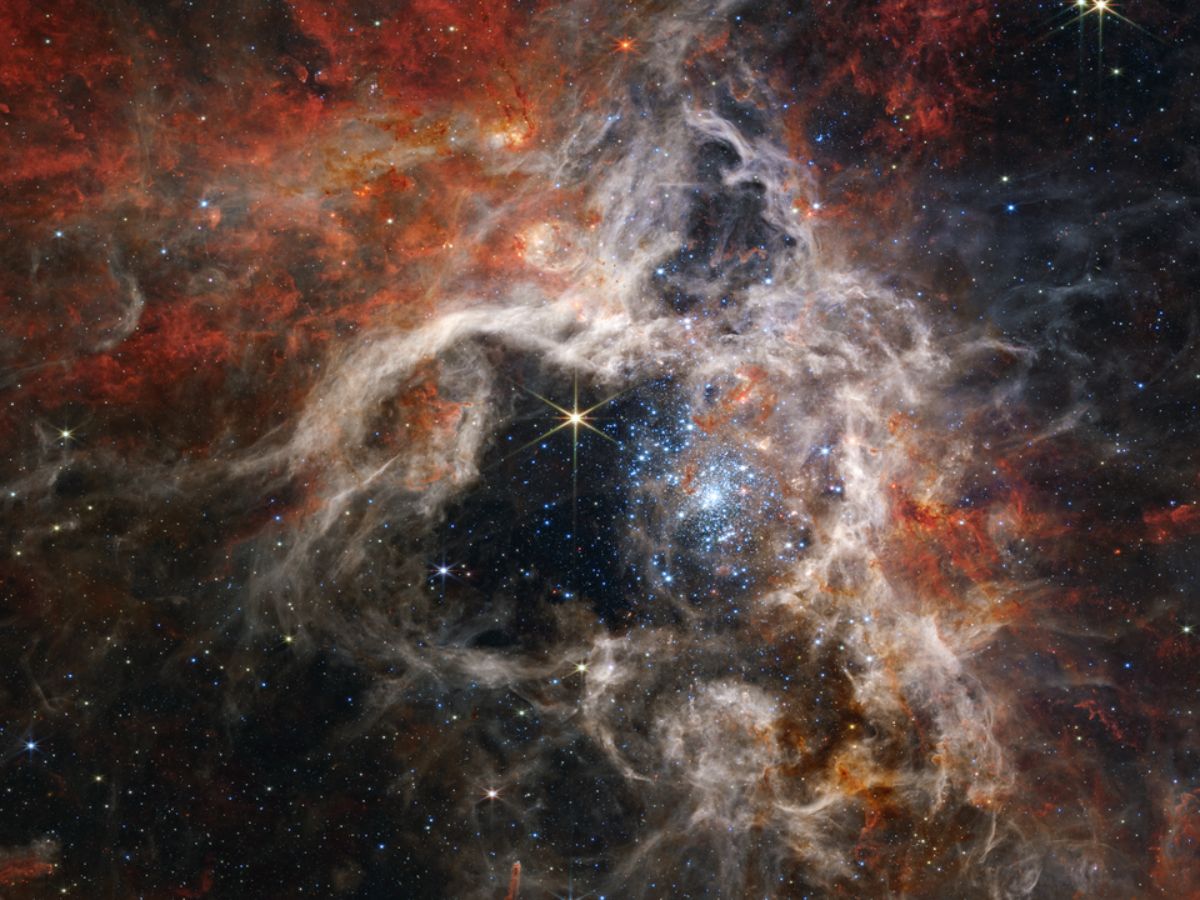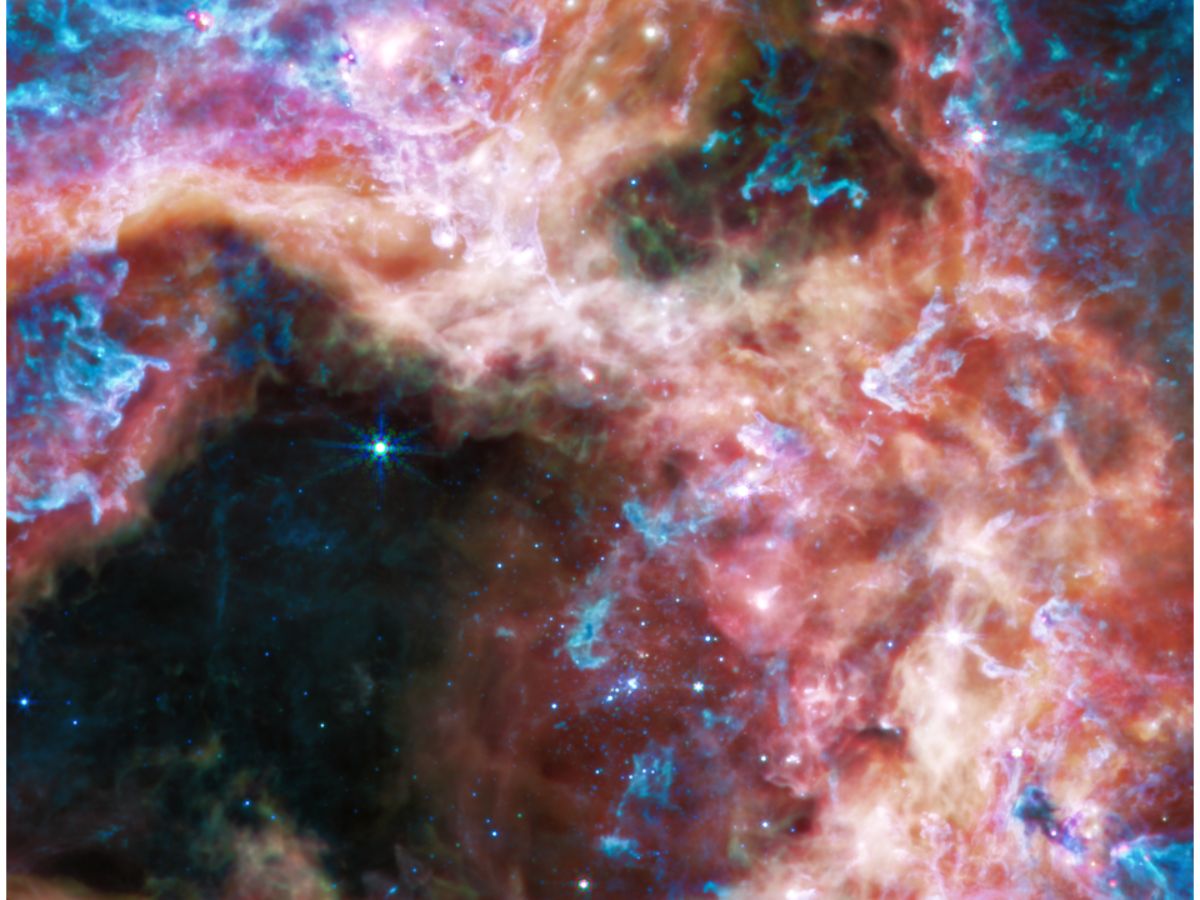James Webb Space Telescope Unveils 'Never-Before-Seen' Stars In Tarantula Nebula
NASA's James Webb Space Telescope, the most powerful space telescope in the world, has unveiled a cosmic creation by imaging never-before-seen young stars in the Tarantula Nebula.

NASA's James Webb Space Telescope (JWST) has captured young stars in a stellar nursery called Tarantula Nebula. Also known as 30 Doradus, the nebula is popular among astronomers studying star formation.
Webb, the most powerful space telescope in the world, has unveiled a cosmic creation by imaging 'never-before-seen young stars' in the Tarantula Nebula, according to NASA. The telescope has also captured distant background galaxies and the detailed structure and composition of the stellar nursery's gas and dust.
The Tarantula Nebula is located 1,61,000 light-years from Earth in the Large Magellanic Cloud galaxy. The nebula is the largest and brightest star-forming region in the Local Group, the galaxies nearest to our Milky Way galaxy.
What Webb’s Images Tell Us About The Tarantula Nebula
In previous telescope images, the dusty filaments of the Tarantula Nebula can be seen. The stellar nursery is home to the hottest, most massive stars known. Astronomers captured the latest image of the Tarantula Nebula by focusing three high-resolution instruments of Webb in the nebula.
When the Tarantula Nebula is viewed with Webb's Near-Infrared Camera (NIRCAM), the stellar nursery resembles the home of a burrowing tarantula, lined with silk. The cavity of the nebula is centred in the NIRCam image. Blistering radiation from a cluster of massive young stars has hollowed out the cavity of the nebula. The young stars sparkle in blue in the image.

The densest surrounding areas of the Tarantula Nebula resist erosion by the young stars' powerful stellar winds. The densest regions form pillars which appear to point back toward the cluster. According to NASA, the pillars contain forming protostars, which will eventually emerge from their dusty cocoons and take their turn shaping the nebula. Protostars are very young stars that are still gathering mass from their parent molecular clouds.
ALSO READ: NASA's James Webb Space Telescope Captures Its First Image Of An Exoplanet
Webb's picture of the Tarantula Nebula is a mosaic image stretching 340 light-years across. Webb's Near-Infrared Camera (NIRCam) reveals the star-forming region of the Tarantula Nebula in a new light. The image shows tens of thousands of never-before-seen young stars that were previously shrouded in cosmic dust.
Webb's view of the Tarantula Nebula through the Near-Infrared Spectrograph (NIRSpec) shows a very young star. Earlier, astronomers thought the star might be a bit older and already in the process of clearing out a bubble around itself.
However, Webb's powerful instrument showed that the star was only just beginning to emerge from its pillar, and still maintained an insulating cloud of dust around itself.
Astronomers would not have known about this episode of star formation-in-action without Webb's high-resolution spectra at infrared wavelengths.
Webb's Mid-Infrared Instrument (MIRI) has captured longer wavelengths of light from the Tarantula Nebula. MIRI's view has revealed that the hot stars fade, and the cooler gas and dust glow.

Points of light within the stellar nursery clouds indicate embedded protostars, still gaining mass.
Dust grains in the nebula absorb or scatter shorter wavelengths of light. However, longer mid-infrared wavelengths penetrate the dust. Webb has captured these wavelengths, revealing a previously unseen cosmic environment.
ALSO READ | Listen In: A New, Immersive Way To Explore NASA James Webb Space Telescope Images, With Sound
Webb's Mid-Infrared Instrument (MIRI) has captured longer wavelengths of light. Through this instrument, Webb has focused on the region surrounding the central star cluster. The telescope has unveiled a very different view of the Tarantula Nebula.
In the longer wavelengths of light, the young hot stars of the cluster fade in brilliance, and glowing gas and dust come forward. In the image, the hydrocarbons are shown in blue and purple. These hydrocarbons light up the surfaces of the dust clouds.
Tarantula Nebula May Unravel Secrets From The ‘Cosmic Noon’
The Tarantula Nebula has a chemical composition similar to that of the gigantic star-forming regions observed at the universe's "cosmic noon", a term used to describe the period when the cosmos was only a few billion years old, and star formation was at its peak.
According to NASA, the star-forming regions in the Milky Way galaxy have a chemical composition different from that of the star-forming regions in the Tarantula Nebula. Also, the star-forming regions of the Milky Way are not producing stars at the same furious rate as the Tarantula Nebula.
ALSO READ | 'Stellar Gymnastics': What NASA Webb Has Captured In Rarely Seen Cartwheel Galaxy
Therefore, the Tarantula Nebula is the closest example of what was happening in the universe as it reached its brilliant high noon. The world's most powerful telescope will provide astronomers the opportunity to compare and contrast observations of star formation in the Tarantula Nebula with Webb's deep observations of distant galaxies from the actual era of cosmic noon.
Humans have observed stars for thousands of years. Despite this, the star-formation process still holds many mysteries.
Astronomers could not unravel some mysteries around stars due to the previous inability to obtain crisp images of what was happening behind the thick clouds of stellar nurseries.
The James Webb Space Telescope, which is only getting started on rewriting the stellar creation history, has already begun revealing a universe never seen before.
Related Video
Southern Rising Summit 2024: How Important is Self-Awareness? Insights from Anu Aacharya | ABP LIVE







































